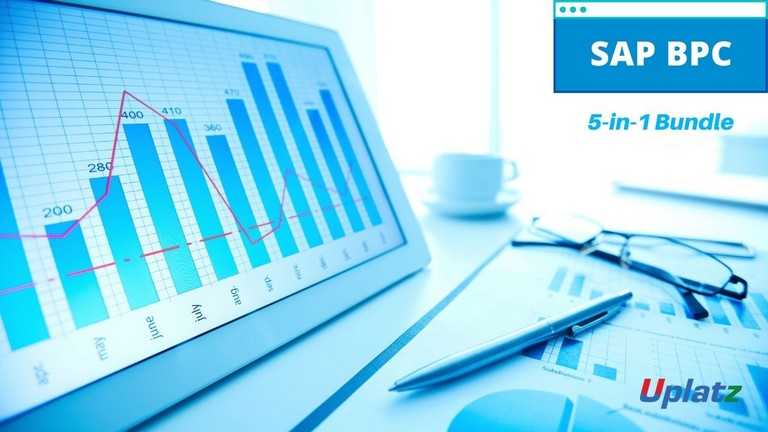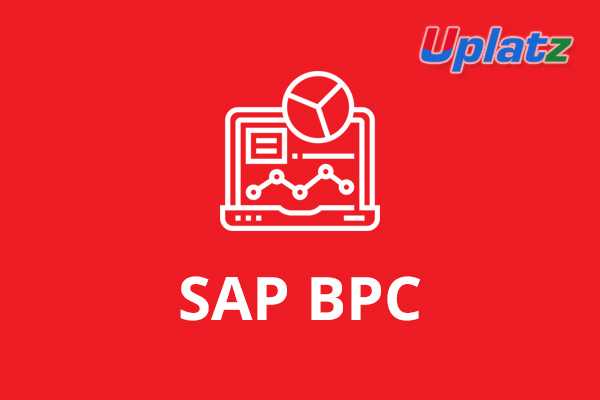SAP BPC (basic to advanced)
Learn about design BPC Embedded using best practices in a comprehensive end-2-end setting, & more.Preview SAP BPC (basic to advanced) course
View Course Curriculum Price Match Guarantee Full Lifetime Access Access on any Device Technical Support Secure Checkout Course Completion Certificate 78% Started a new career
BUY THIS COURSE (GBP 29)
78% Started a new career
BUY THIS COURSE (GBP 29)
-
 76% Got a pay increase and promotion
76% Got a pay increase and promotion
Students also bought -
-

- Bundle Multi (5-in-1) - SAP BPC
- 125 Hours
- GBP 49
- 1384 Learners
-

- Career Path - SAP Functional Consultant
- 500 Hours
- GBP 299
- 7893 Learners
-

- SAP BPC (Business Planning and Consolidation)
- 30 Hours
- GBP 29
- 1504 Learners

SAP Business Planning and Consolidation (BPC) tool is used to support all operational and financial activities in an organization.
SAP BPC helps in automating and streamlining business forecast, planning, and consolidation activities in your organization. SAP BPC is a corporate performance management tool that focuses on financial budgeting & consolidation, which is helpful to plan & forecast varied types of business processes implemented in any organization. Along with planning, BPC suite is also useful for consolidation of data metrics and provides a combination of appropriate & accurate reports.
SAP BPC is a comprehensive SAP suite and helps businesses plan, forecast, allocate budget and control their core operations. It’s a performance management tool that offers critical planning and controlling schedules for business processes. SAP BPC is integrated with MS-Excel enabling better reporting along with custom dashboards and can also work with the SAP Netweaver Database. SAP BPC allows comprehensive data analysis enabling better business management. The module is being increasingly used by enterprises across the world for its extensive features and skilled SAP BPC consultants are in very high demand with an attractive pay and excellent career prospects.
Features of SAP BPC module - SAP BPC module facilitates the planning & consolidation of these activities in one package.
1) It allows the user to make better business decisions by supporting What-If analysis and allows you to perform scenario-based planning.
2) It allows you to collaborate data and thus increase accuracy in business planning and accountability.
3) It helps in aligning your plans with strategic goals and hence decrease the cycle time.
4) Unified: Planning and Consolidation in One Product. Single application decreases maintenance, improve data integrity, and streamlines the organization. It additionally it empowers flexible planning & consolidation functions.
5) Owned and Managed by Business Users: Business clients manage processes, models and reports with less IT dependence.
6) An open, versatile application: Increase the value of your investment in SAP as well as the non-SAP environment.
7) Familiar, Easy to utilize: It is user-friendly & support Microsoft office tools & web browsers that access central database.
8) Align Financial and Operational designs: It is useful to determine financial objectives and operational plans with vital goals.
9) Reduces budget cycle time: It helps to decrease budget cycle time.
Uplatz offers this detailed SAP BPC course that includes in-depth instruction on primary tasks of an administrator of SAP BPC. In this course you will explore creating and running data manager packages and managing environments, models, and dimensions. You will also discover how to secure dimensions and how to provide users with specific tasks and data profiles. You will also learn how to streamline business processes by creating process templates and managing business process flows, and much more!
Course/Topic - SAP BPC (basic to advanced) - all lectures
-
In this lecture session of SAP BPC (basic to advanced) we learn SAP BPC from scratch to advance level. In this session we cover both planning and concentration.
-
In this session we learn how to operate master data in excel and cover how to save the master data and basic of SAP BPC.
-
In this lecture session of SAP BPC (basic to advanced) we talk about the dimension and how to use the additional dimension require.
-
In this lecture session we learn about we learn about administration of environmental shell and also cover how login in administration of environmental shell.
-
In this lecture session we talk about dimensions and models and also cover all the basic techniques of SAP BPC and how to create dimensions and define the models in brief.
-
In this session we learn how to calculate fixed assets from total number of assets and cover basic formulas of excel.
-
In this lecture session of SAP BPC (basic to advanced) We talk about position local members and learn how to change total assets to balance sheet.
-
In this lecture session of SAP BPC (basic to advanced) We learn about plan budgeting and forecasting and cover how to access the SAP easy and validation and maintenance
-
In this session we talk about advance level of reporting In this lecture first we run the advance level reporting and also cover all the formulas.
-
In this session we talk about SAP NetWeaver and also cover how to login in SAP NetWeaver and the advance use of SAP NetWeaver in SAP BPC.
-
In this lecture we talk about EPM functions and cover all types of EPM functions. This is the 7.1 session of lecture series of SAP BPC (basic to advanced).
-
In this lecture session of SAP BPC (basic to advanced) we learn about Mapping and also cover all the types and techniques of mapping.
-
In this video we talk about work status. Basic functionality of work status and how we work on work status.
-
In this lecture session of SAP BPC (basic to advanced)we learn about security path and how security path work.
-
In this session we learn about dimensions and models. How we create dimension to structure data and also define theirhierarchies, member and properties.
-
In this lecture session of SAP BPC (basic to advanced) we learn about steps of budget processing and cover all importance if budget processing.
-
In this video we learn about keywords how we use keywords in SAP BPC (basic to advanced) and best techniques of using keywords.
-
In this lecture session of SAP BPC (basic to advanced) we learn abouth collecting data and how we share the collected data.
-
In this video session we learn about how create a reporting application and cover all types of reporting application.
-
In this video session we talk about SAP business objects and cover all the objects of SAP in SAP BPC.
-
In this lecture session of SAP BPC (basic to advanced) we talk about carry forwarding the data and how we manage the balance sheet carry forwarding data.
-
In this lecture session we talk about logic script and business rules and cover all types of business rules.
-
In this lecture session of SAP BPC (basic to advanced) we learn aboutconsolidation monitor and cover all techniques of consolidation monitor.
-
In this video session we talk about how to start a page and how to enter the text in the start text.
-
In this lecture session of SAP BPC (basic to advanced) we learn about advance level SAP BPC business rules and how to manage the master data in excel.
-
In this video session we talk about planning solution and cover all multiple models including in planning solution in SAP BPC.
-
In this last session of SAP BPC (basic to advanced) we talk about what we learn in the last videos it’s a revision session of SAP BPC (basic to advanced).
- • Learn how to position SAP Business Planning and Consolidation.
- • Plan and Report in Analysis for Office version for Excel.
- • Use business process flows and work status for planning scenarios.
- • Learn how to design BPC Embedded using best practices in a comprehensive end-2-end setting.
- • Learn to configure the SAP BPC planning environment as an administrator, advanced reporting techniques, tools and application configuration, etc.
SAP BPC (basic to adv) – Course Syllabus
• Script Logic and Calculations
• Business Rules
• EPM add-in
• Integrated Planning
• BW Integration
• Models
• Environments and Dimensions
• Administration
• Data Manager
• Analysis for Office
• BPC Web client consolidation
• Process Control
• Architecture
The SAP BPC (basic to advanced) Certification ensures you know planning, production and measurement techniques needed to stand out from the competition.
SAP Business Planning and Consolidation (BPC) tool is used to support all operational and financial activities in an organization. SAP BPC helps in automating and streamlining business forecast, planning, and consolidation activities in your organization.
Controls in BPC can be set up by the system administrator to ensure that when users complete a financial process, that the transactional data submitted meets certain standards as set by the administrator of the system.
The SAP Business Planning and Consolidation (SAP BPC) application delivers planning, budgeting, forecasting, and financial consolidation capabilities, so you can easily adjust plans and forecasts, speed up budget and closing cycles, and ensure compliance with financial reporting standards.
Uplatz online training guarantees the participants to successfully go through the SAP BPC (basic to advanced) Certification provided by Uplatz. Uplatz provides appropriate teaching and expertise training to equip the participants for implementing the learnt concepts in an organization.
Course Completion Certificate will be awarded by Uplatz upon successful completion of the SAP BPC (basic to advanced) online course.
The SAP BPC (basic to advanced) draws an average salary of $115,000 per year depending on their knowledge and hands-on experience.
The maintenance of SAP BPC, version for Microsoft 10.1 will continue until end of 2024, following explicit customer requestsAfter the stated deadlines, there will be no further prolongations and maintenance will be customer specific, according to SAP Note 52505.
SAP professionals design, implement and deploy SAP solutions to achieve defined business goals. Maintain skills in SAP applications process design and configuration; SAP application design, development, integration, testing and deployment; and SAP application technical architecture.
Note that salaries are generally higher at large companies rather than small ones. Your salary will also differ based on the market you work in.
Consultant: SAP BPC.
SAP BPC Developer- Sr Analyst.
SAP BPC Consultant.
Q1. What is BPC?
Ans: BPC stands for Business Planning and Consolidation. BPC is used for both Planning and Consolidations, unlike IP, which is used for only planning.
Q2. When BPC 7.5 NW is available?
Ans: The 7.5 version is currently in the ramp-up stage and should be available in a few months. I am not sure of the exact month.
Ans:
- SAP BPC NetWeaver
- BPC MS
Q4. BPC for NW has an aggregation level or not, Is BPC an application on top SAP-IP?
Ans: BPC and IP have completely different architecture. BPC doesn’t use aggregation levels or filters. BPC and IP have no relation and thus, cannot be compared. BPC uses various script logics, business rules for doing the planning. Manual planning can be done with input schedules. The input schedules are on the excel platform and are quite versatile. You can use BPC functionalities along with native excel functionalities for better design of the input schedules.
Q5. What about BPC in the consolidation part?
Ans: BPC comes with pre-delivered components for consolidation, which can be leveraged on. There are a few business rules, which make the consolidation process easier.
Q6. What is the concept of plan data from BPC?
Ans: The concept of planning is the same as you have in any other tool. The functional side of the planning remains the same. However, the tool differs. The way you configure a planning scenario will be much different than any other planning tool. Unfortunately, it will not be feasible to address this in the forum. You can definitely go through the study materials for a better understanding.
Q7. BPC for NW needs to install .NET application server and Web server or not?
Ans: Yes, You can have a look at the installation guide available on the marketplace for detailed requirements.
Ans:
- Star Schema for Exceptional Reporting: SAP BPC uses NW InfoCubes to store the data. The dimension model used is extended Star Schema so it makes BPC with the NW system an exceptional system for reporting.
- No Database Dependence Version: BPC NW version is not dependent on database version and can run common databases like DB2, Oracle, SQL Server, etc.
- BW Accelerator Support: SAP NetWeaver BW accelerator tool is an additional feature that can be used to enhance the performance of reporting in the system even if you are using large datasets. It indirectly helps in saving the cost for a company as less number of report performance issues are reported.
- Badi Development and ABAP Support: SAP BPC with NetWeaver allows you to use ABAP programming to develop K2 script logic. It enables the creation of a business add-in BAdi interface in the back-end system, which can be called later from script logic developed in the BPC system. It helps in solving the complex business requirements and reducing the development time for an organization.
Q9. What is the BPC client tool? And If I planning on the BEx report, I have to create an aggregation level for planning data or not?
Ans: BPC client sits on the client machines, from where; you will be doing the design. There are mainly 3 interfaces available - BPC Admin, BPC Office, and BPC Web. BPC Office, in turn, has 3 interfaces - Excel, Word, PowerPoint. These interfaces can be used for various requirements.
Q10. Can you debug the data manager package?
Ans: UJD_TEST_PACKAGE.You must specify the User ID. The DM package can be selected with F4.
Q11. What are scoping commands?
Ans: The following keywords can be used to modify the scope: *XDIM_MEMBERSET Overwrites the scope for that dimension *XDIM_ADDMEMBERSET Add members to the scope of that dimension *XDIM_FILTER Filters the members of the scope of that dimension *XDIM_MAXMEMBERS Specifies the maximum number of members that should be included in one query (per dimension)
Ans:
- Dimension Logic − This can be configured in the BPC system using simple mathematical formulas.
- Business Rules − This allows you to create rules in the BPC system to perform specific functions.
- K2 Script Logic − This is used to perform some specific functions which can’t be achieved using out-of-box functionality to meet the business requirements. You can create K2 script logics to perform certain functions, which can be performed in a standard system.
Q13. What are the system variables?
Ans: %USER% - Returns current SAP Business Objects Planning and Consolidation User %APPSET% - Returns current SAP BusinessObjects Planning and Consolidation AppSet (Application Set) %APPLICATION% - Returns current SAP BusinessObjects Planning and Consolidation Application %YEAR% - Returns current calendar year.
Q14. What is the difference between EVGTS and EVANS?
Ans: EVGTS: The EVGTS (Get value and scale) function retrieves a data value based on the specified members, and scales the value if the scale property is enabled on the dimension. The report templates provided in the sample application set have a scale reference in the Control Panel area of the template.
EVSND: EVANS This Send function references another cell and sends its value to the database when you select Send and Refresh Schedules. The parameters specify the dimensions that identify where the data value is to be sent in the database. EVSND returns the value from the database to the referenced cell. You do not need to add any EVGET functions to the sheet to return values to the cell. Since the values are returned to the referenced cell, BPC sends only the cells that have changed since the last send in the current session. By putting the formula in the EVANS cell and not in the input cells, you decrease the chances of your formulas getting overwritten or erased. To further protect the formulas, you may want to hide the EVSND cells in the input schedule. This function takes members that not specified from the current view settings.
Q15. What is the difference between DRILLDOWN and DRILL THROUGH?
Ans: Drill down is different than drill through. Drill down is used to drill down on member data within dimensions. You can drill down on members in a worksheet, or you can drill down on charts and graphs. Drill down is conducted within one report in the Excel interface whereas drill through is a 'jump' outside of the Excel Interface.









